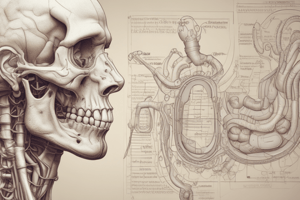Podcast
Questions and Answers
What is the approximate weight of the liver in a healthy adult?
What is the approximate weight of the liver in a healthy adult?
- 0.5-1.0 kg
- 3.0-3.5 kg
- 2.0-2.5 kg
- 1.2-1.5 kg (correct)
Which of the following is NOT a function of the liver?
Which of the following is NOT a function of the liver?
- Cardiovascular regulation (correct)
- Metabolism
- Detoxification
- Elimination of substances
What is the percentage of liver's blood flow carried by the hepatic artery?
What is the percentage of liver's blood flow carried by the hepatic artery?
- 75%
- 90%
- 25% (correct)
- 50%
What is the name of the functional units of the liver at the microscopic level?
What is the name of the functional units of the liver at the microscopic level?
What is the location of the liver in the human body?
What is the location of the liver in the human body?
What is the main function of the portal vein?
What is the main function of the portal vein?
What is the name of the small blood vessels between the radiating rows of hepatocytes?
What is the name of the small blood vessels between the radiating rows of hepatocytes?
What is the relative size of the right lobe compared to the left lobe of the liver?
What is the relative size of the right lobe compared to the left lobe of the liver?
What is the function of Kupffer cells in the liver?
What is the function of Kupffer cells in the liver?
What is the main function of the liver's excretory and secretary function?
What is the main function of the liver's excretory and secretary function?
What is the purpose of the portal area in the liver?
What is the purpose of the portal area in the liver?
What is the liver's role in the coagulation function?
What is the liver's role in the coagulation function?
What is the liver's role in the detoxification of foreign materials?
What is the liver's role in the detoxification of foreign materials?
What is the liver's role in the metabolism of hormones and ingested drugs?
What is the liver's role in the metabolism of hormones and ingested drugs?
What is the liver's role in the storage function?
What is the liver's role in the storage function?
What is the liver's role in the hematological function?
What is the liver's role in the hematological function?
Flashcards are hidden until you start studying
Study Notes
Structure of the Liver
- The liver is the largest internal organ of the human body, weighing approximately 1.2-1.5 kg in a healthy adult.
- It is divided unequally into two lobes by the ligament, with the right lobe being approximately six times larger than the left lobe.
- The liver has dual blood supply through the hepatic artery (25% of liver's blood flow) and the portal vein (75%).
Microscopic Structure
- At the microscopic level, the liver consists of hexagonal-shaped functional units called hepatic lobules.
- Hepatic lobules consist mostly of hepatocytes arranged in thin layers that radiate from the central canal to the peripheral of the lobule.
- Between the radiating rows of hepatocytes are small blood vessels called sinusoids that contain specialized macrophages called Kupffer cells.
- Kupffer cells act as active phagocytes capable of engulfing bacteria, debris, toxins, and other substances flowing through the sinusoids.
Functions of the Liver
- Metabolic function
- Storage function
- Synthetic function
- Excretory and Secretary function
- Protective and Immunological function
- Coagulation function
- Hematological function
- Detoxification function
Specific Functions
- Stores glycogen, vitamins A, D, E, K, and B12, iron, and copper.
- Produces and secretes most blood proteins, including coagulation factors (fibrinogen, prothrombin, etc.).
- Removes harmful substances (e.g. ammonia and toxins) from the blood and breaks them down or transforms them into less harmful compounds.
- Metabolizes most hormones and ingested drugs to rather more or less active products.
- Serves as a gatekeeper between substances absorbed by the gastrointestinal tract and those released into systemic circulation.
Bilirubin and Bile
- Bilirubin is produced and metabolized in the liver.
- Bile drains from hepatocytes by many small bile ducts that unite to form the main bile duct of the liver (hepatic duct).
- The hepatic duct joins the cystic duct, which leads from the gallbladder, to form the common bile duct, which drains into the duodenum.
Studying That Suits You
Use AI to generate personalized quizzes and flashcards to suit your learning preferences.



